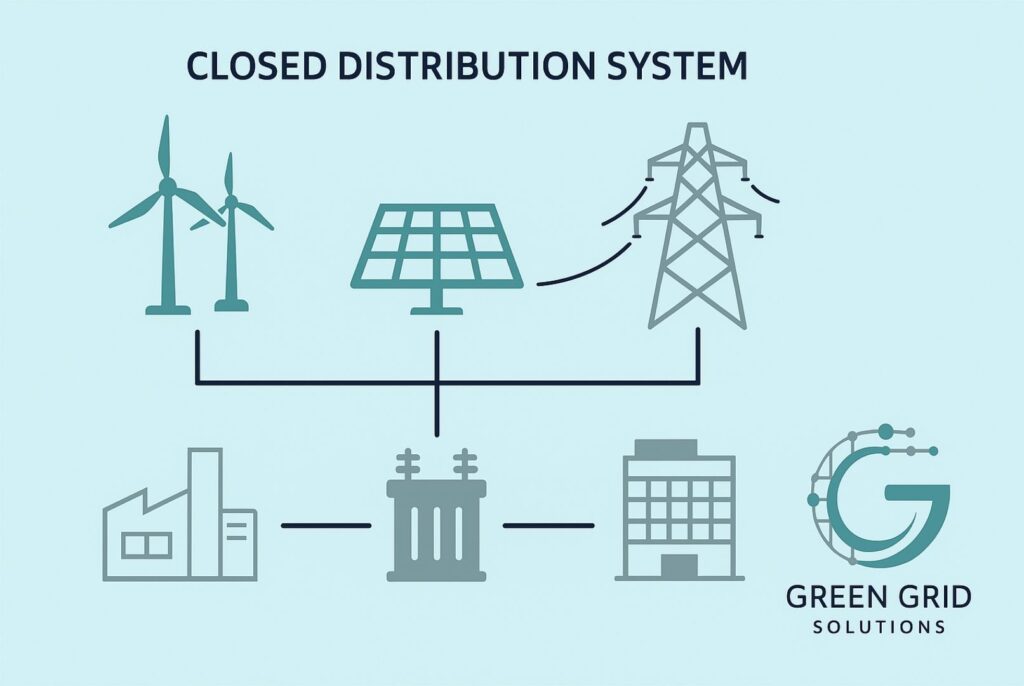- Posted on
- Thijs Afman
Closed Distribution Systems in EU Energy Projects

Closed Distribution Systems (CDS) are a special category of electricity distribution network defined by EU law for integrated energy sites. Under the EU Electricity Directive (2009/72/EC, as recast by Directive 2019/944), a CDS allows certain private grids to operate with tailored regulation. For example, Recital (66) of the Directive explains that CDS are meant for cases requiring “optimal efficiency of an integrated supply requiring specific operational standards,” or where the system is maintained primarily for the site owner’s own use eur-lex.europa.eu.
Article 38(1) of the Directive then sets out two core conditions that a network must meet to qualify as a CDS eur-lex.europa.euenergy.ec.europa.eu. In summary, the network must:
- Be confined to one site: The grid covers a single industrial, commercial, or shared-services site and does not serve ordinary household customers energy.ec.europa.eu. It should be geographically limited so that external users cannot connect to it.
- Serve integrated operations (Condition A): For specific technical or safety reasons, the operations or production processes of the site’s users must be integrated. For example, a factory complex where multiple plants share heat and power generation can meet this test eur-lex.europa.eu.
- Serve primarily the owner/affiliates (Condition B): The network must distribute electricity mainly to the owner or operator of the system or to their related companies. In practice, this means most power on the grid is used by the owner’s operations (or its affiliates), not by unrelated customers eur-lex.europa.eu.
- Exclude typical households: The network must not serve regular household customers. (A very small number of households belonging to on-site employees may be allowed as “incidental use” eur-lex.europa.eu, but the overall household load must be negligible.)
Only when all of these criteria are satisfied can a system be classified as a CDS. Otherwise it remains a conventional distribution network subject to normal regulation. Importantly, CDS operators are still considered Distribution System Operators: they must comply with general DSO obligations (for example, offering network access to eligible users) energy.ec.europa.eu.
Examples of Closed Distribution Systems in Practice
Several types of projects have been recognized as fitting the CDS concept in the EU:
- Industrial or logistics parks: Multi-company factory or port sites often share on-site generation and distribution. For instance, a chemical manufacturing park with its own CHP plants and interconnected grid can qualify as a CDS due to its integrated energy supply eur-lex.europa.eu. Many industrial sites inherently meet the confined-site requirement and have tightly coupled energy flows.
- Major transport and institutional sites: Large campuses such as airports, railway stations or hospital complexes typically run private electricity networks to meet high reliability and safety needs. These sites may include co-owned renewables or energy storage for optimization. The Directive explicitly lists examples like airports and hospitals as typical CDS use cases eur-lex.europa.eu.
- Energy hubs and microgrids: Emerging projects where multiple companies co-invest in local wind, solar or battery assets can also form a CDS, if the output primarily serves those owners. In such cases, the shared generation and loads are centrally coordinated, satisfying the “integrated supply” criterion.
These examples are illustrative. Actual CDS classification depends on national regulatory approval and the specifics of each project.
Why Regulators Sometimes Reject CDS Status
Regulators closely scrutinize CDS applications to ensure the concept is not misused to avoid normal grid rules. Common reasons for denial include:
- No genuine integration: If the users on the network operate largely independently without a true shared technical need, then criterion (a) fails. In practice, each user on a CDS should rely on the common grid for efficiency or safety.
- Serving unrelated customers: A CDS must be “closed” to outsiders. If the proposal involves selling power to independent third parties (for example, neighboring businesses or consumers), it fails the “primarily owner” test. The Commission explicitly noted that structures like shopping centers or office complexes not primarily owned by a single undertaking do not qualify as CDS energy.ec.europa.eu.
- Non-confined or excessive household load: If the network spans multiple disconnected sites or serves ordinary households, it is not “closed.” Only incidental household use (e.g. employee homes on site) is permitted eur-lex.europa.eu. A system with significant household or external connections will be treated as a public network.
- Attempt to bypass third-party access: Remember that closed DSOs remain DSOs under EU law. They must allow any legally entitled party to access the grid energy.ec.europa.eu. Any CDS design that looks like a scheme to block competitors or avoid regulated tariffs is likely to be rejected.
In sum, EU regulators now apply the CDS criteria stringently. If a network proposal does not convincingly meet both the integration and owner-serving conditions, it will be regulated under the standard distribution regime.
Conclusion: Collaboration and Next Steps
Closed Distribution Systems can offer regulatory flexibility for truly integrated energy sites, but eligibility is strictly limited eur-lex.europa.eueur-lex.europa.eu. Energy developers should carefully assess whether their projects genuinely meet the legal criteria. It is wise to engage early with national regulators, clearly document the technical and contractual arrangements that demonstrate integration, and ensure compliance with all DSO obligations.
Call to action: Developers across the EU are encouraged to consult the EU Electricity Directive and national regulator guidance when planning private networks. Share experiences and questions in industry forums and with regulatory peers to clarify how CDS rules apply in practice. By working collaboratively—with project teams, DSOs and regulatory authorities—we can implement innovative local energy systems that deliver efficiency gains while staying fully compliant with EU law.
